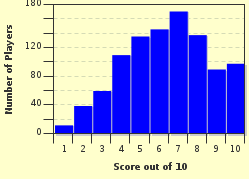Quiz Answer Key and Fun Facts
1. As mentioned in the introduction, you are a chemical compound. You will therefore not be found on the periodic table. Which of these *can* be found on the periodic table?
2. By telling you that you contain 22 protons in total, you should gather that you are a relatively small compound. If I were also to tell you that you are uncharged, what could you tell me about the number of electrons you contain?
3. Electrons are also significant in determining the molecular shape of compounds. For example, your electron arrangement about your central atom gives you a linear shape. Which shape is formed when there are 4 bonding pairs of electrons about a central atom of a compound and no lone pairs?
4. You, as a chemical compound, are also a vital part in some of the most important metabolic reactions in nature. For example, you are produced during cellular respiration, but are not the desired product. What term is used to describe a product like this?
5. Another quality of yours is that you react with water to form an acidic solution. However, you only form a weak acid. Which of these examples is also classed as a weak acid?
6. You exist as a gas at room temperature. Here, room temperature is taken to be a value between 20 and 25 degrees Celsius. According to IUPAC, what term is used to describe conditions of 0 degrees Celsius?
7. If bubbled through limewater, you will make it turn milky - this is a chemical test for your presence in a mixture. Which molecule can be detected by tests using the chemical, ninhydrin?
8. You are an intermediate product of an industrial process which intends to separate iron from its ore. A well known iron ore is hematite. Which of these ores does not contain iron?
9. People talk a lot about you and your effect on the environment. It therefore surprises many that you only make up 0.038% of the Earth's atmosphere. Does the noble gas, argon, make up more or less of a proportion of the Earth's atmosphere than you?
10. From the information you have gained in questions 1 to 9, can you tell me which chemical compound you are?
Source: Author
doublemm
This quiz was reviewed by FunTrivia editor
crisw before going online.
Any errors found in FunTrivia content are routinely corrected through our feedback system.

